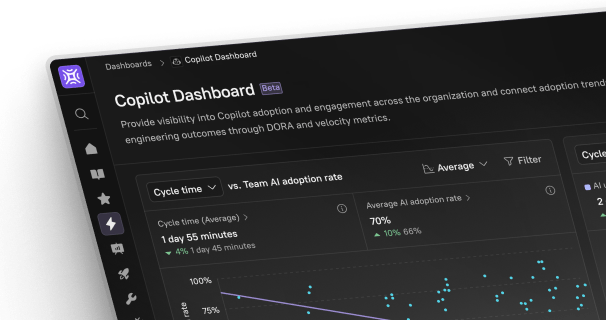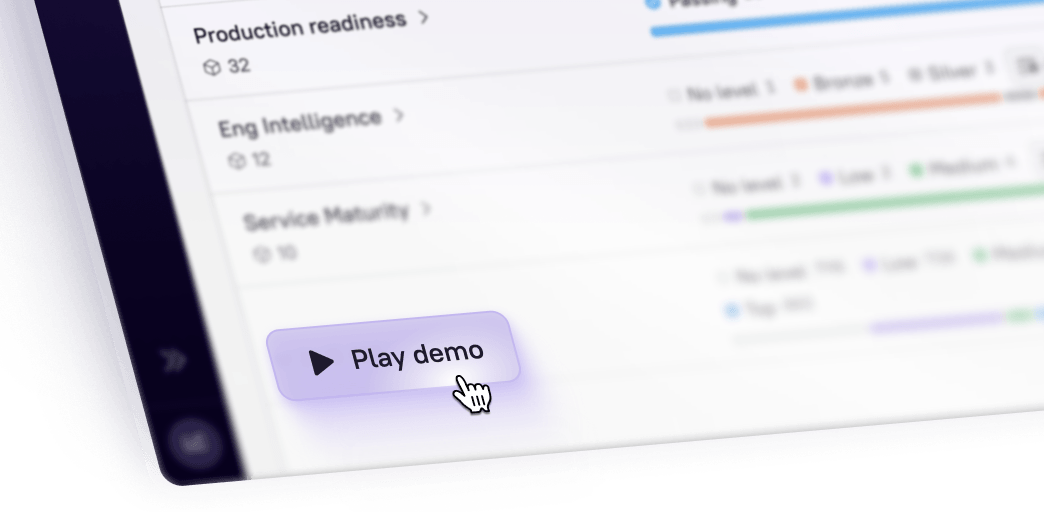As engineering teams scale their systems and adopt microservices architectures, maintaining consistent reliability becomes increasingly complex. Service Level Objectives (SLOs) help site reliability engineers (SRE) quantify reliability, make data-driven decisions about service performance, and keep everyone on track to achieve engineering excellence.
But implementing effective SLOs requires aligning engineering efforts with business outcomes. Whether you're dealing with a handful of services or hundreds of microservices, understanding how to define SLOs and implement them effectively can mean the difference between proactive reliability management and reactive firefighting.
What are service level objectives (SLOs)?
SLOs are your engineering team's internal commitment to service reliability. Think of them as the guardrails that help you balance feature velocity with system stability. SLOs provide visibility without which you run the risk of experiencing major downtime and not identifying issues until after they have severely impacted user experience.
They are often measured in terms of users’ satisfaction with the service, but the way that's measured depends on the function and user expectations of the service. They can represent either business (e.g. runtime), technical (e.g. dependencies), or service (e.g. performance) metrics.
Consequently, an SLO is not the expectations themselves but the degree to which you want the product to meet those expectations. For example, you could set the expectations at 100%, but your SLO would be set at 98%, i.e., you would intend for the service to do what it is supposed to do and meet users’ expectations 98 out of 100 times.
While they're not customer-facing commitments, they drive the technical decisions that ultimately impact the user experience. SLOs should be stricter than your SLAs to give you a buffer zone for addressing issues before they affect your contractual obligations.
The differences between SLOs, SLAs, and SLIs
The terms SLO, SLA, and SLI are often used interchangeably, but they're quite different. Understanding the nuances can help you build effective service reliability practices.
Service level agreements (SLAs)
SLAs translate your technical capabilities into business commitments. They're the contracts you sign with customers that specify what happens when the level of service isn’t met. It's important to keep enough space between your SLOs and SLAs to handle unexpected issues. If the product is unreliable and fails to meet certain requirements, it means the team has not met expectations. This can result in having to compensate the end users.
A common pattern is setting SLOs at least one order of magnitude tighter than your SLAs. For example, if your SLA promises 99.5% availability, your SLO might target 99.9%.
Service level indicators (SLIs)
SLIs are where the rubber meets the road—they're the actual metrics you track to determine if you're meeting your objectives. Effective SLIs should directly measure what users experience. For example, instead of an internal metric like tracking CPU usage, measure request latency, which is what users actually feel. Here are some typical SLIs:
Request latency from the user's perspective
Error rates across critical user journeys
System throughput during peak loads
Availability of key business functions
Data durability for critical user information
How to define and set effective SLOs: 4 steps
Many teams either aim too high (creating unnecessary operational burden) or too low (risking user satisfaction) when they're setting SLOs. While every company operates slightly differently, there are some universal steps that all teams can follow to establish a strong foundation.
1. Understand your customers' needs
Setting SLOs starts with understanding what reliability means to your users. Engineers often focus on technical metrics like uptime or response time, but customer experience is more nuanced.
To translate customer needs into meaningful SLOs, start by looking at user behavior patterns, common customer incident reports, and session data to understand user dropoff. Talk to customer success teams about common reliability complaints and get feedback from sales teams about competitive deals where reliability was the pain point.
Take into account the different reliability requirements of users. For instance, an e-commerce checkout service needs stricter SLOs than a product recommendation engine. Map your services to business impact:
High-impact services (payment processing, user authentication): Set aggressive SLOs
Medium-impact services (search, product listings): Balance reliability with cost
Low-impact services (analytics, reporting): Set more relaxed objectives
2. Set baseline metrics
Many teams make the mistake of setting SLO targets before understanding their current performance. This approach often leads to unrealistic objectives that either create unnecessary stress or get ignored entirely. Instead, get at least 30 days of historical performance data, and look for patterns in your existing metrics and external factors that influence performance.
It's important to distinguish between normal variance and actual issues. Your baseline measurements should help you understand what "normal" looks like for your services, including expected peak loads and seasonal patterns.
3. Define SLIs and error budgets
While SLOs are the targets that you hope to reach, service level indicators are quantitative measures or metrics that help determine the actual quality of service being delivered to users. You are probably already tracking all sorts of metrics, but we recommend selecting a few that are especially reflective of user experience to be marked as SLIs.
Many metrics, such as CPU usage, do not directly impact the users’ experience of your product and will not make for helpful SLIs. Only metrics that demonstrate a strong relationship with the degree to which your users are satisfied are worth considering.
Once you have baseline data, you can set meaningful targets and error budgets. An error budget is a measure of the number of negative events you can have on a metric before your SLO is considered to have been violated. It's the gap between perfect reliability (100%) and your SLO target. Identifying the error budget can also take some experimentation as you figure out how to define the scope of reliability for your product.
4. Iterate and refine
SLOs need regular refinement, so schedule regular time to review SLO performance monthly with stakeholders and adjust thresholds based on customer feedback. Make sure to document the reasoning behind each change, so you have a record for future reference.
Refinement is a fine balance between keeping SLOs consistent enough to be meaningful and updating them when business needs change.
Essential metrics for SLO management
While every service is different, certain metrics are consistently valuable across different architectures and use cases. Start with these types of metrics that directly impact user experience:
Latency metrics, such as time to first byte for content delivery and backend processing duration
Availability metrics, such as success rate of API requests and failed transaction percentage
Traffic metrics, such as concurrent user sessions and network throughput
Resource utilization, such as CPU and memory usage patterns
User experience, such as customer satisfaction (CSAT) scores
Business performance, such as revenue impact during degraded performance
In microservices environments, internal developer portals (IDPs) help track service health across numerous components. They help teams maintain visibility into service performance and quickly identify potential issues before they impact customers.
Best practices for implementing SLOs
Teams often struggle with inconsistent measurement, unclear ownership, and difficulty maintaining SLOs as systems evolve. These best practices will help set up your SLOs for success:
Use an internal developer portal
An IDP serves as the single source of truth for your SLOs by centralizing all definitions and current performance metrics in one location. It helps teams track service dependencies and their impact on composite SLOs while automating essential reporting and alert management functions. Teams can see the historical context for SLO decisions, so they can make informed decisions about future modifications.
Automate SLO tracking
Implement automated data collection for all SLIs to ensure tracking is consistent and reliable. Real-time dashboards and intelligent alerting based on error budget burn rates help teams identify issues before they become critical.
Establish clear ownership
Assign primary team responsibility for each SLO and define explicit ownership for shared dependencies to prevent confusion during incidents. Create clear escalation paths for SLO breaches that specify who should be notified and when.
Involve stakeholders early
Include product managers in SLO target discussions to ensure alignment with business goals and customer expectations. Customer success teams can give valuable perspective on user impact, so involve them early on and regularly review SLOs to make sure they're aligned with business priorities.
Segment SLOs by service type
Define service tiers based on business impact and set appropriate SLOs for each tier rather than applying one-size-fits-all targets. Consider regional variations in service requirements and account for different customer segments when setting reliability targets. This helps teams focus their reliability efforts where they matter most.
Incorporate redundancy
Build reliability into your architecture by implementing circuit breakers for critical dependencies and deploying services across multiple availability zones. Design systems for graceful degradation with fallback options for critical functionality to maintain service availability even during partial outages.
Document and communicate
Maintain up-to-date SLO definitions and measurement methods in a central location accessible to all teams. Create clear incident response playbooks that guide teams through common failure scenarios and share regular SLO performance reports to maintain visibility across the organization.
Set up accurate SLOs fast with Cortex
While implementing SLOs can be complex, the right tooling makes a difference in setup and maintenance. Cortex helps teams implement and manage SLOs effectively across their microservices architecture. Here's how leading teams are using Cortex to improve their SLOs:
Engineering excellence through connected insights
Cortex connects engineering output to business outcomes by providing comprehensive visibility into system and team performance. The Eng Intelligence feature leverages your existing SLO data to help teams measure and improve their effectiveness. This integration between reliability metrics and team performance creates a feedback loop that drives continuous improvement and engineering excellence.
Unified service visibility
Cortex's service catalog provides a complete view of your microservices landscape in a single location. Teams can visualize service dependencies, track ownership, and monitor critical metrics from one central dashboard. This helps teams understand how their SLOs interact with dependent services and quickly identify potential reliability issues before they affect customers.
Automated reliability tracking
Cortex automates tracking SLO compliance through scorecards that continuously evaluate service health against predefined objectives. Teams receive real-time insights into service performance and can quickly identify when services drift from their reliability targets.
Streamlined incident management
When incidents occur, context is critical. Cortex integrates with your existing incident management tools to provide immediate access to relevant service information, dependencies, and historical performance data. Teams can correlate SLO breaches with root causes more quickly, leading to faster resolution times and more effective post-incident learning.
Production readiness assessment
Before setting SLOs, teams need confidence that their services are ready for production traffic. Cortex provides built-in tools for assessing service production readiness, ensuring all necessary components and metrics are in place. This systematic approach helps teams set realistic and achievable SLOs while maintaining high reliability standards.
Standardized SLO implementation
Consistency in SLO implementation becomes increasingly important as your service count grows. Cortex's platform provides templates and workflow automation that help teams standardize their approach to SLO definition and management. This standardization reduces setup time and ensures consistent reliability practices across all services.
To learn more about Cortex, book a demo.





